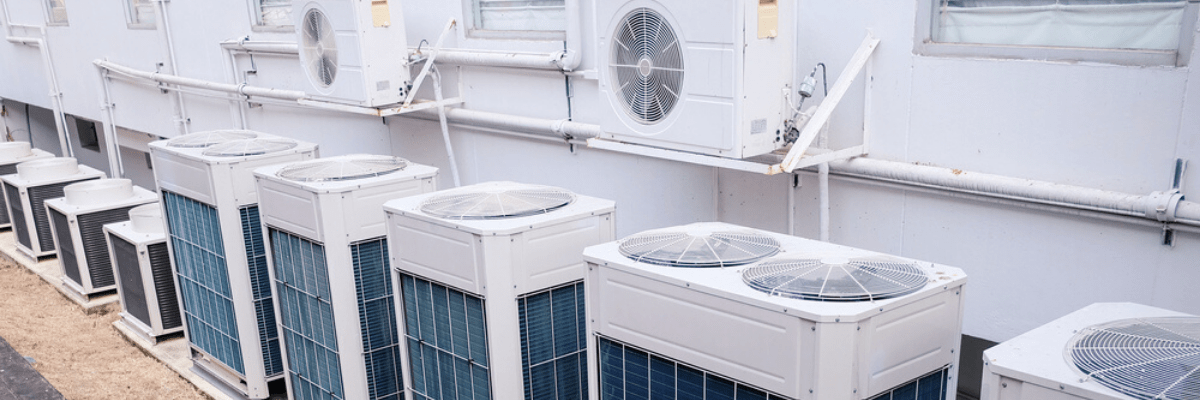If you’re thinking about starting a career in HVAC and Refrigeration service, now is a great time to learn everything you can about the work and the industry. Let’s get started with an overview of the different types of air conditioners commonly used here in the New York City area.
When it comes to air conditioning, there are many more options beyond window units and the split-system units commonly used for central air conditioning in suburban homes.
6 different types of air conditioners you’ll work on as an HVAC technician in NYC
While window units are certainly common in New York City, as a service tech it’s unlikely that you’ll spend much time (if any) working on them. That’s because they are inexpensive units that often cost more to repair than to replace.
So, let’s look at other types of air conditioning systems you’ll encounter much more often in your career as a service technician.
Packaged Terminal Air Conditioning (PTAC) units
Chances are, you’ve seen PTAC air conditioning units in hotel rooms. They are installed through the outside wall of the building. They look a lot like window units (but are typically bigger).
They work very much like window air conditioners as well, although some units also provide heat. PTAC units are self-contained systems that have coils, fans, electrical components, and refrigerant lines all within a single box. Like window units, PTACs are older technology that’s noisy and can’t effectively cool more than a single room.
In New York City, you’ll find PTAC units in older buildings, especially some of the historic buildings in Manhattan where landmark building restrictions make it impossible to install more efficient modern systems.
Ductless mini-splits
Ductless split systems or mini-splits are a great air conditioning option in buildings or spaces where it’s difficult or impossible to install ducts.
Ductless mini-splits are small systems that are not practical for a large space. However, they are often used to supplement an existing air conditioning system. For example, they can provide cooling for a room addition or a computer room that needs extra cooling.
“Split systems” get their name because they require two separate equipment components: the compressor and condensing unit (often called the outdoor unit) and the evaporator coil and air handling unit (often called the indoor unit). Condensers and air handler units are connected by conduits with refrigerant and electrical lines.
In Manhattan, where there’s not much outdoor space, condensing units can be installed in mechanical rooms with access to outside air, or under a window on the outside of the building.
Since there are no ducts to distribute air throughout the space, each room needs its own air handling unit to blow cooled air into the room. These small units are typically mounted in the ceiling or on a wall.
Ducted split systems
Ducted split systems are the types of air conditioners typically found in suburban homes. They can effectively cool spaces up to 10,000 square feet, and multiple systems can be combined to cool large areas.
Like mini-splits, ducted split systems have condenser and compressor units as well as a single, larger air handler/evaporator unit. The two components are also connected by refrigerant and electrical lines. In a ducted system, one central air handler unit produces large volumes of cooled air that get distributed throughout the space through a system of ductwork installed in walls and ceilings. Especially in Manhattan, where space is at a premium, you’ll find some very creative ductwork designs!
Condenser units are installed outside where possible, under a window, or in mechanical rooms. The air handler may be installed in a ceiling if there’s enough clearance. You’ll often find them in closets! In a ducted system, air handlers might be connected to a furnace or heat pump that supplies heat to the space.
Just 5 years ago, 75% of new residential air conditioning installations in the city were ducted split systems. Today, their popularity is down to about 25% due to the development of VRF technology.
Rooftop units (RTU)
Rooftop units, as you might guess from the name, can be found on the rooftops of large commercial buildings. Most often, they are used for single-story buildings such as warehouses, shopping centers, and big box retail stores. However, in the city where we have to be creative, they are sometimes used for taller buildings (up to 10 stories) and can sometimes be installed on the side of the building.
RTUs provide not only cooling, but also heating and ventilation for the building. RTUs are sometimes called “packaged units” because a single assembled unit includes all the components of an air conditioning and heating system. It has a condenser and an evaporator coil for cooling, a heat source and a fan for forced air heating, and an opening to bring in outside air.
Rooftop systems can be easier to install and maintain than other types of air conditioners, since all the equipment is self-contained in one box. However, rooftop access can sometimes be a challenge.
VRF systems
If you’ve never heard of a Variable Refrigerant Flow (VRF) air conditioning system, you’ll probably assume it’s new technology. The truth is, it’s relatively new to the US (within the past 5-10 years), but VRF systems have been widely used in Europe and Asia for quite some time. Here in New York, they are becoming increasingly popular for Manhattan brownstones and also for commercial HVAC systems.
Like split systems, VRF systems are refrigerant based and have outdoor condenser units and indoor air handler/coil units. However, VRF systems can precisely control the flow of refrigerant (hence the name) with a variable speed compressor that runs only at the capacity needed for the current conditions. That means better comfort conditions, quieter operation, and energy efficiency.
VRF systems use multiple indoor air handlers to create individually-controlled comfort zones within the space. And they can reuse residual heating released during the cooling process, so they can provide some heat in addition to cooling, and even both at the same time to different zones.
VRF systems are complex and require specialized training to install and service. However, the efficient design means these systems tend to be more reliable over the long term.
Water-cooled base building systems
Many New York City highrise buildings have what’s called “base building” cooling systems that serve the entire building. Water-cooled base systems are efficient when it comes to both space usage and energy consumption for a large building.
Water-cooled systems use chilled water to remove heat from the air. Chilled water is pumped from a large chiller unit (often located in the basement or a mechanical room) through pipes to fan coil units throughout the building. Fans circulate air over the chilled water-cooling coils. The chilled coils absorb heat from the air, then the treated air is returned back into the space. The water returns to the chiller, where it is cooled again.
In buildings with a base system, tenants are often responsible for installing equipment that takes the volume of chilled air from the base system and distributes it throughout the tenant’s space. Variable air volume (VAV) units may be used to direct varying amounts of cool air to different rooms.
More HVACR training resources for aspiring technicians
Our mission here at HVACR Career Connect is to support men and women entering our trade with helpful information. So, check out our Resources and Training pages!
Also, here’s another article that shares a wealth of industry resources: HVAC Resources for Service Technicians.

